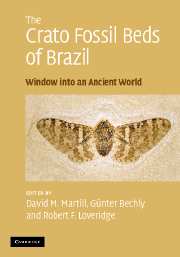Book contents
- Frontmatter
- Contents
- Contributors
- Preface
- Acknowledgements
- Part I The Crato Formation Konservat Lagerstätte
- Part II The invertebrate fauna
- 7 Taphonomy and preservation of Crato Formation arthropods
- 8 Chilopoda: centipedes
- 9 Arachnida: spiders, scorpions and allies
- 10 Crustacea of the Crato Formation
- 11 Insects of the Crato Formation
- Part III The vertebrate fauna
- Part IV The flora
- Part V Miscellanea
- Appendix: species list for the Crato Formation
- Systematic index
- Plate section
- References
10 - Crustacea of the Crato Formation
Published online by Cambridge University Press: 22 August 2009
- Frontmatter
- Contents
- Contributors
- Preface
- Acknowledgements
- Part I The Crato Formation Konservat Lagerstätte
- Part II The invertebrate fauna
- 7 Taphonomy and preservation of Crato Formation arthropods
- 8 Chilopoda: centipedes
- 9 Arachnida: spiders, scorpions and allies
- 10 Crustacea of the Crato Formation
- 11 Insects of the Crato Formation
- Part III The vertebrate fauna
- Part IV The flora
- Part V Miscellanea
- Appendix: species list for the Crato Formation
- Systematic index
- Plate section
- References
Summary
Although crustaceans are often abundant and diverse in fossil Konservat Lagerstätten, their remains are remarkably rare in the Nova Olinda Member and, indeed, they are only abundant at a few localized horizons in the Crato Formation as a whole. Reasons for this rarity compared with other fossil Lagerstätten are unclear, but are probably related to salinity levels and substrate chemistry. By far the most abundant crustaceans are ostracods, which occur in rock-forming quantities in shales and fissile laminated muddy limestones at the transition between the Rio da Batateiras Formation and the Crato Formation at Cascata, near Crato. In these same deposits conchostracans occur with the ostracods at Cascata, although they are not as abundant, and in dark-coloured silty shales beneath a series of laminated limestones at Estiva, near Araporanga. Here they occur without ostracods, but in a sequence that is similar to, though slightly younger than, that at Cascata. Decapod crustaceans have only been reported from the laminites of the Nova Olinda Member in the Crato Formation.
Decapoda: Beurlenia, the ‘sole’ shrimp from the Crato Formation
The Crato Formation yields only a single species of decapod crustacean: Beurlenia araripensis. Originally described as a palaemonid shrimp by Martins-Neto and Mezzalira (1991), Maisey and Carvalho (1995) cast doubt on its palaemonid affinities, referring it to? Palaemonidae. Palaemonids are a family within Caridea that are scarcely recorded from the fossil record. We here concur with Maisey and Carvalho (1995) and transfer B. araripensis to Familia incertae sedis within Caridea.
- Type
- Chapter
- Information
- The Crato Fossil Beds of BrazilWindow into an Ancient World, pp. 133 - 141Publisher: Cambridge University PressPrint publication year: 2007
References
- 1
- Cited by

